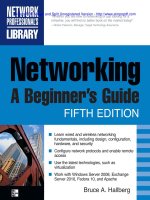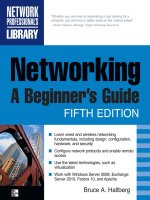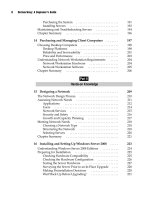Networking: A Beginner’s Guide Fifth Edition- P42 pdf
Bạn đang xem bản rút gọn của tài liệu. Xem và tải ngay bản đầy đủ của tài liệu tại đây (96.19 KB, 5 trang )
187
Chapter 13: Network Servers: Everything You Wanted to Know but Were Afraid to Ask
N In-case temperature
N Operating system hangs
N Computer case opening
Any of these errors might indicate a current or impending problem with the server. For
example, a 1-bit memory error that is corrected by the system’s ECC memory might not
cause a problem for the server because it was corrected, but it might indicate that a RAM
chip or bank of RAM is starting to experience trouble. Similarly, climbing temperatures in
a case might not cause an immediate problem, but may indicate that a fan isn’t operating
properly, has a blocked intake, or is facing another problem, and ultimately temperatures
higher than those allowed for in the server design will cause a failure.
Server state monitoring solutions can alert you to problems either via e-mail or
through a pager. Some even operate if power is lost to the server or the server room
(this is called “lights-out” capability). Many high-end servers also offer “prefailure”
warranties that state that the manufacturer will replace any components reporting even
minor errors, so you can replace them before serious trouble actually strikes. For those
servers you depend on to be the most reliable possible, such monitoring and warranty
features can be a real lifesaver.
Hot-Swap Components
Most modern servers include hot-swap components that you can replace while the
system continues to operate. Usually, hot-swap components are limited to disks, power
supplies, and fans, all of which are running in a redundant configuration. For example,
a system might have two power supplies; if one fails, the system still operates normally
and you can replace the failed power supply without needing to turn off the server.
Similarly, most RAID disk configurations enable you to replace a failed drive without
shutting down the server, provided the disks are installed in a hot-swap configuration.
TIP Many RAID disk systems enable you to install a standby disk, and the system itself uses that
standby disk to replace any failed drive automatically. Of course, you would then replace the actual
failed disk as soon as possible, and the replacement becomes the standby disk for the disk array.
Choosing Servers for Windows and NetWare
In this section, you learn about the basics of defining server needs, selecting a server,
and purchasing a server.
Defining Server Needs
Before looking at different server models, you need to understand clearly the needs
that the server has to meet. Otherwise, you risk either under- or over-purchasing
hardware, both of which can cause problems and might lead you to spend more than
188
Networking: A Beginner’s Guide
you needed to spend. Under-purchasing leads to additional, unplanned purchases,
which might include adding more disks or more memory, or even needing to replace
the server much too soon. Over-purchasing means you spent more for a server than
necessary, which might lead your company to deny your request for a particular server.
Instead, you need to find the “sweet spot” for specifying just the right server for your
needs; then you can defend your required configuration and its cost. You can’t do any
of this unless you have clearly defined your needs.
To specify the needs for a server clearly, you must be able to answer all the following
questions:
N What is the useful life of the server? How long do you expect to use the server?
Will you replace it in two, three, or four years? (Most servers are used for
around three years before being replaced.) Everyone should agree on this time
frame, because if you plan to replace the server in two years, you can get by
with a smaller server than if you need one to last three or four years. If you
specified a server capable of meeting two years’ needs, however, you don’t
want to get to the end of two years and then find out that your company won’t
approve a replacement.
N What job will the server perform? Will it be a file and print server, a web server,
a database server, or some other kind of server?
N How many users will the server support and what are the needs of those users?
For example, with a file and print server, you must estimate the storage and
bandwidth requirements needed to satisfy all the planned users’ requests. For
a database server, you must know how quickly the server needs to respond to
various database operations.
N How reliable must the server be? What are the consequences (costs and impacts)
if the server crashes for one or more hours, or for a day or two?
N Will you use clustering for the server? Clustering is a technique whereby
multiple servers share the same essential job. If one fails, everything keeps
working, albeit at a slower rate. Once the failed server is repaired, it can then
be added back to the cluster.
N How safe must the data on the server be from loss? This is different from the
preceding question because you might have cases in which a server must never
lose data, even if it isn’t a big deal if the server goes down for a few hours. In
such a situation, you would use a RAID 1 or RAID 10 configuration, but you
might not care too much about, say, redundant power supplies. You might also
explore some kind of hierarchical storage scheme, where data is automatically
copied to tape or optical disk in real time, or where you make several live
incremental backups of files each day.
N If the server fails, what are your backup plans? Do you plan to keep a hot-spare
server (one that’s ready to be swapped in at a moment’s notice for a failed
server) available or do you plan simply to rely on the server manufacturer’s
189
Chapter 13: Network Servers: Everything You Wanted to Know but Were Afraid to Ask
service capabilities? Also, sometimes if a server fails, other existing servers
might temporarily meet some of its needs. For example, in a Windows network,
if a domain controller fails, you can have other domain controllers to provide
this necessary functionality for the network as a whole. Or you might have
redundant printer queues defined on another server, ready to be made available
if the primary print server fails.
N How do you plan to back up the server? Do you plan to have a tape drive on
the server itself, or do you plan to back it up over the network to some other
server’s backup device? Do you plan to make backups while the server is being
used, or overnight when it’s not being used? These are important questions
to answer, because if you host the backup device on the server, you also need
to have backup software on the server. If you plan to back up a server while
it’s being used, you need a fast backup system connected to a fast server bus
to minimize the impact to the users during the day. If you plan to back up a
server over a network connection, you need a network connection fast enough
to handle the amount of data on the server. Think carefully about your backup
plans when specifying a server.
N How could the demands placed on the server change over time? Is the company
aggressively hiring more employees, so that the server might need to support
twice as many users a year from now and four times as many users two years
from now? Make sure you understand the company’s overall plans and factor
them into your assessment of server needs. Also, even in companies where
the number of users is relatively static, the amount of storage required by each
user will still grow rapidly. A rule of thumb is to estimate that current storage
requirements double every 18 months, everything else being equal. If you have
historical data for how much storage users consume, this data can help you
estimate your system’s requirements even more accurately. (And don’t forget
to anticipate any new network services that could more rapidly increase your
storage needs!)
N Does the new server need to work with any existing hardware? If you need to
reuse a network backup device, for instance, you should make sure that the
new server can properly support it (and vice versa).
N How much physical room do you have available to house the server? Are you
compelled by space requirements to go with the smallest server possible?
Once you answer these questions and any others that might crop up, you’re ready
to start looking at different servers that can meet the needs you defined.
Selecting the Server
Aside from choosing the types of equipment you need for a server, you must remember
three basic prerequisites that all your server purchases should meet: compatibility,
compatibility, and compatibility. If your NOS starts displaying error messages on
190
Networking: A Beginner’s Guide
a particular server, you’ll need fast responses to these types of problems. If you built a
server yourself by buying a motherboard, a disk controller, a video card, and so forth,
you’re not going to get effective support, either for the hardware or for any compatibility
problems that crop up with the software. For both Novell and Microsoft NOSs, make
sure that each part of the server—as well as the entire system collectively—is certified by
Novell or Microsoft for its respective NOS.
For Microsoft operating systems, go to the following URL to look at Microsoft’s
Hardware Compatibility List (HCL) and make certain that the hardware you like is
certified:
/>When selecting servers, you often select a manufacturer first and then select the
actual model you need. This is because, everything being equal, you’re slightly better off
if all your servers are from the same maker. Managing servers from one manufacturer is
much easier than managing servers from many manufacturers. You can do a better job
of stocking spare parts that might fit into all of your servers, and you can build a better
relationship with the manufacturer or a particular dealer, which might hold additional
benefits. For example, Dell lets companies certify their in-house technicians on Dell
hardware (including servers), and then allows them order parts more directly, bypassing
the first level of support (the first support people’s job being mainly to intercept the easy
questions that beginners ask), and also provides other benefits.
Be conservative in selecting servers and server brands. You should stick with the
top names in the industry for many reasons, including these:
N They have much more established service organizations and practices
N They are likely to offer higher-quality support
N Because so many other networks are based on their equipment, their technical
support databases probably already contain any problems you may encounter,
and they probably have fixes available
N The NOS vendor is also more likely to have data on any problems concerning
one of the top servers
N They have much better in-house engineering, and their servers are likely to
perform better and to be more reliable
These are just the biggest reasons. You might remember a time when the mantra in
management information systems (MIS) departments was, “Nobody ever got fired for
buying IBM.” A similar type of mindset makes sense when buying servers, not only
because the purchase is more defensible, but because buying from major manufacturers
actually makes better business sense, for the reasons cited in the preceding list.
Remember these general differences when you select a server for either NetWare
or Windows networks: First, while any server is RAM-hungry, Windows servers work
better with more RAM than an equivalent NetWare server. If everything else is equal,
plan on giving a Windows server 50 to 100 percent more RAM than a NetWare server.
191
Chapter 13: Network Servers: Everything You Wanted to Know but Were Afraid to Ask
Also, database servers are RAM-hungry for databases of any appreciable size (10GB
or larger), so plan on using at least 2GB of RAM. (4GB to 8GB of RAM isn’t out of the
question for the best possible performance).
Windows servers can operate with up to 8 or 32 processors. A Windows server
will work very well with two or four processors. Also, remember that with a single
processor, NetWare servers tend to perform better than Windows servers. Depending on
the actual application, a NetWare server can outperform a Windows server by 15 to
30 percent, even if you’ve already added more RAM to the Windows server configuration.
Both Windows and NetWare server systems can implement certain RAID levels
themselves. For the best performance, however, you should select a disk controller that
can take this burden off the NOS. High-throughput disk controllers also often have a
significant amount of RAM on them for caching disk data, and they usually have their
own processor to help handle their chores. Moreover, I recommend you use a SCSI-based
disk subsystems on a server. A workstation running Windows performs equally well
with either SATA or SCSI, but a server can take advantage of SCSI’s features to improve
performance significantly over SATA disk interfaces. SCSI drives also have a tendency to
be more reliable than SATA drives.
Choosing your actual disk configuration is relatively straightforward. You start
by determining your current and planned space requirements, and then you consider
your performance and reliability needs to choose a particular RAID level that makes
sense. (See the “Disk Topologies: It’s a RAID!” section earlier in this chapter for more
information.) Once you know these requirements, you can choose the amount of disk
space you need and ensure that the server you want can handle your current and
planned disk space needs.
Remember this tip: You’re better off knowing what your disk requirements will be
over time and planning to purchase additional disk space as the need arises. This is
because the capacity of disk drives increases at a rapid rate, while prices fall at a rapid
rate. Buying a 1TB drive a year from now, for example, will be less expensive than
purchasing the same drive today. Just make sure that the server you select can handle all
the drives that you plan to purchase, and then install those drives as needed to save your
company money. For NetWare servers, also remember that the optimal amount of RAM
depends on the amount of disk space in the server, so you want to plan on purchasing
more RAM when you add any significant amount of disk space. But, happily, the
same rule of thumb for disks holds true for RAM: Prices tend to spiral downward, and
tomorrow’s RAM will almost certainly be much less expensive than today’s RAM.
If you plan to purchase a server for Windows Server, you might also want to consider
selecting a system that accepts additional processors. This way, if you find the system is
becoming bottlenecked at the processor level, you can install more processors to reduce
or remove that bottleneck.
Purchasing the System
Once you decide on the server you want, purchasing it is relatively straightforward. Shop
around and get the best price on the system you want. Make sure that the suppliers you
approach offer the level of support you need, both for presales selection assistance and
for postsales support.









